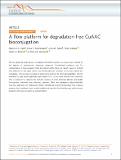Files in this item
A flow platform for degradation-free CuAAC bioconjugation
Item metadata
| dc.contributor.author | Hatit, Marine Z. C. | |
| dc.contributor.author | Reichenbach, Linus F. | |
| dc.contributor.author | Tobin, John M. | |
| dc.contributor.author | Vilela, Filipe | |
| dc.contributor.author | Burley, Glenn A. | |
| dc.contributor.author | Watson, Allan J. B. | |
| dc.date.accessioned | 2018-10-11T09:30:09Z | |
| dc.date.available | 2018-10-11T09:30:09Z | |
| dc.date.issued | 2018-10-01 | |
| dc.identifier | 255966388 | |
| dc.identifier | 8d7cba95-e933-4308-be45-feda12bdf6e6 | |
| dc.identifier | 85054082814 | |
| dc.identifier | 000446113000023 | |
| dc.identifier.citation | Hatit , M Z C , Reichenbach , L F , Tobin , J M , Vilela , F , Burley , G A & Watson , A J B 2018 , ' A flow platform for degradation-free CuAAC bioconjugation ' , Nature Communications , vol. 9 , 4021 . https://doi.org/10.1038/s41467-018-06551-0 | en |
| dc.identifier.issn | 2041-1723 | |
| dc.identifier.other | ORCID: /0000-0002-1582-4286/work/56639187 | |
| dc.identifier.uri | https://hdl.handle.net/10023/16187 | |
| dc.description | We thank Vapourtec for the copper reactors, the EPSRC UK National Mass Spectrometry Facility at Swansea University for analyses, the University of Strathclyde for PhD studentship (M.Z.C.H.), the Leverhulme Trust for a postdoctoral fellowship (L.F.R.; grant no. RPG-2014-001), and the BBSRC for funding (grant nos. BB/R006857/1, BB/N016378/1). | en |
| dc.description.abstract | The Cu-catalyzed azide-alkyne cycloaddition (CuAAC) reaction is a cornerstone method for the ligation of biomolecules. However, undesired Cu-mediated oxidation and Cu-contamination in bioconjugates limits biomedical utility. Here, we report a generic CuAAC flow platform for the rapid, robust, and broad-spectrum formation of discrete triazole bioconjugates. This process leverages an engineering problem to chemical advantage: solvent-mediated Cu pipe erosion generates ppm levels of Cu in situ under laminar flow conditions. This is sufficient to catalyze the CuAAC reaction of small molecule alkynes and azides, fluorophores, marketed drug molecules, peptides, DNA, and therapeutic oligonucleotides. This flow approach, not replicated in batch, operates at ambient temperature and pressure, requires short residence times, avoids oxidation of sensitive functional groups, and produces products with very low ppm Cu contamination. | |
| dc.format.extent | 7 | |
| dc.format.extent | 1312603 | |
| dc.language.iso | eng | |
| dc.relation.ispartof | Nature Communications | en |
| dc.subject | QD Chemistry | en |
| dc.subject | NDAS | en |
| dc.subject | BDC | en |
| dc.subject.lcc | QD | en |
| dc.title | A flow platform for degradation-free CuAAC bioconjugation | en |
| dc.type | Journal article | en |
| dc.contributor.institution | University of St Andrews. School of Chemistry | en |
| dc.identifier.doi | 10.1038/s41467-018-06551-0 | |
| dc.description.status | Peer reviewed | en |
This item appears in the following Collection(s)
Items in the St Andrews Research Repository are protected by copyright, with all rights reserved, unless otherwise indicated.

